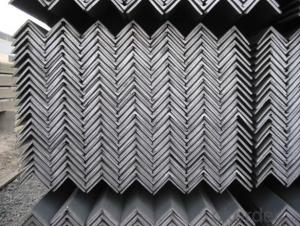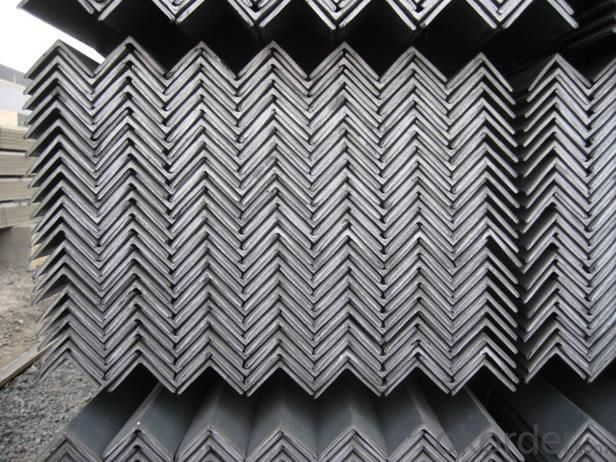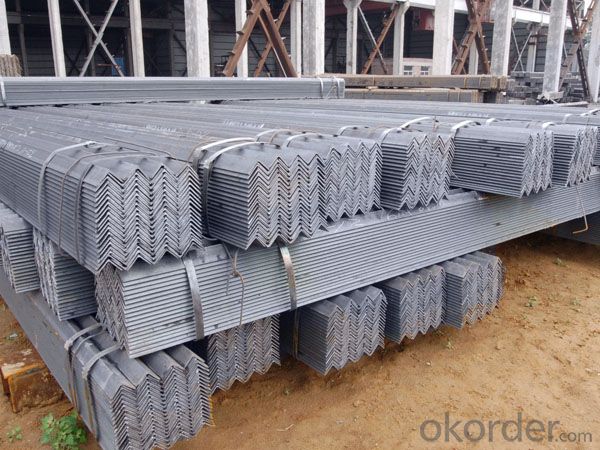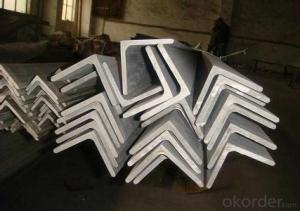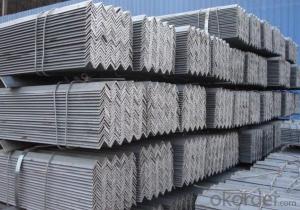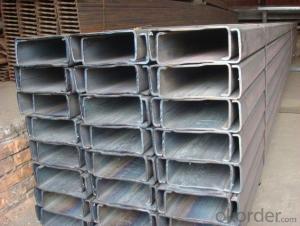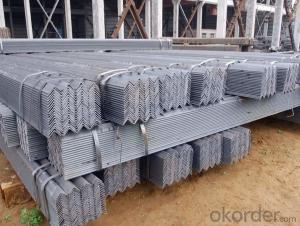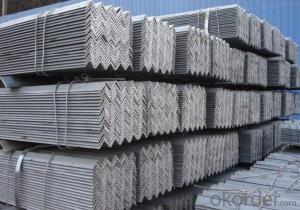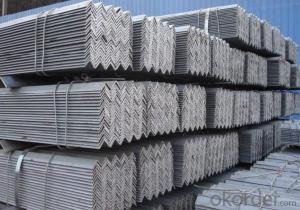ANGLE STEEL 20MM
- Loading Port:
- China Main Port
- Payment Terms:
- TT OR LC
- Min Order Qty:
- -
- Supply Capability:
- -
OKorder Service Pledge
OKorder Financial Service
You Might Also Like
Angle Steel Details:
| Minimum Order Quantity: | 25mtons | Unit: | m.t. | Loading Port: | China Main Port |
| Supply Ability: | 80000-100000MTS/YEAR | Payment Terms: | TT or LC |
Product Description:
Specifications of Angle Steel
1. Invoicing on theoretical weight or actual weight as customer request
2. Length: 6m, 9m, 12m as following table
3. Sizes
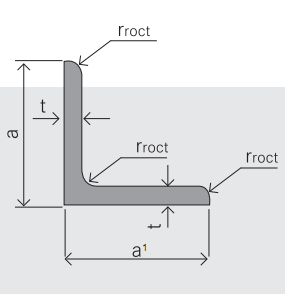
Sizes: 25mm-250mm | ||
a*t | ||
25*2.5-4.0 | 70*6.0-9.0 | 130*9.0-15 |
30*2.5-6.6 | 75*6.0-9.0 | 140*10-14 |
36*3.0-5.0 | 80*5.0-10 | 150*10-20 |
38*2.3-6.0 | 90*7.0-10 | 160*10-16 |
40*3.0-5.0 | 100*6.0-12 | 175*12-15 |
45*4.0-6.0 | 110*8.0-10 | 180*12-18 |
50*4.0-6.0 | 120*6.0-15 | 200*14-25 |
60*4.0-8.0 | 125*8.0-14 | 250*25 |
5. Payment terms:
1).100% irrevocable L/C at sight.
2).30% T/T prepaid and the balance against the copy of B/L.
3).30% T/T prepaid and the balance against L/C
6.Material details:
Alloy No | Grade | Element (%) | | ||||
C | Mn | S | P | Si | | ||
| | |||||||
|
|
|
|
|
|
| |
Q235 | B | 0.12—0.20 | 0.3—0.7 | ≤0.045 | ≤0.045 | ≤0.3 | |
|
|
|
|
|
|
| |
Alloy No | Grade | Yielding strength point( Mpa) | | ||||
Thickness (mm) | | ||||||
≤16 | >16--40 | >40--60 | >60--100 | | |||
≥ | | ||||||
|
|
|
|
|
| | |
Q235 | B | 235 | 225 | 215 | 205 | | |
Alloy No | Grade | Tensile strength (Mpa) | Elongation after fracture (%) | | |||
Thickness (mm) | | ||||||
| ≤16 | >16--40 | >40--60 | >60--100 | | ||
≥ | | ||||||
|
|
|
|
|
|
| |
Q235 | B | 375--500 | 26 | 25 | 24 | 23 | |
Usage & Applications of Angle Steel
According to the needs of different structures, Angle can compose to different force support component, and also can be the connections between components. It is widely used in various building structures and engineering structures such as roof beams, bridges, transmission towers, hoisting machinery and transport machinery, ships, industrial furnaces, reaction tower, container frame and warehouse etc.
Packaging & Delivery of Angle Steel
1. Packing: it is nude packed in bundles by steel wire rod
2. Bundle weight: not more than 3.5MT for bulk vessel; less than 3 MT for container load
3. Marks:
Color marking: There will be color marking on both end of the bundle for the cargo delivered by bulk vessel. That makes it easily to distinguish at the destination port.
Tag mark: there will be tag mark tied up on the bundles. The information usually including supplier logo and name, product name, made in China, shipping marks and other information request by the customer.
If loading by container the marking is not needed, but we will prepare it as customer request.
Production flow of Angle Steel
Material prepare (billet) —heat up—rough rolling—precision rolling—cooling—packing—storage and transportation
- Q: What are the different design considerations for steel angles in industrial buildings?
- Some of the key design considerations for steel angles in industrial buildings include the load-bearing capacity of the angles, the overall structural stability, the desired level of durability and resistance to corrosion, and the aesthetic appearance of the angles. Additionally, factors such as the specific application and function of the angles, the environmental conditions, and the available budget also play a role in determining the design considerations for steel angles in industrial buildings.
- Q: How do steel angles contribute to the overall stability of a truss system?
- Steel angles play a critical role in enhancing the overall stability of a truss system, which is widely utilized in structural applications like bridges and buildings to efficiently distribute loads and provide support. The stability of a truss system relies on the steel angles within it. Firstly, the truss system commonly incorporates steel angles as diagonal members, aiding in resisting both tensile and compressive forces that act on the structure. By strategically placing these steel angles, the truss system gains resistance against lateral loads like wind or seismic forces, which can potentially lead to the structure swaying or collapsing. The diagonal angles effectively transfer these loads to the vertical and horizontal members of the truss, ensuring the stability of the entire system. Furthermore, steel angles contribute to stability by preventing the buckling or twisting of truss members. Buckling refers to the sudden failure of a structural member under compressive stress, while twisting refers to the rotational deformation caused by lateral forces. By incorporating steel angles as bracing elements, the truss system becomes more resistant to these types of deformations. The angles act as rigid supports, preventing the members from buckling or twisting, thus enhancing the overall stability of the truss system. Moreover, steel angles aid in increasing the rigidity of the truss system, which refers to its stiffness and resistance to deformation. By connecting various truss members with steel angles, the overall rigidity of the truss system is improved. This increased rigidity allows the truss to bear heavier loads, providing overall stability and durability to the structure. In conclusion, steel angles are crucial in contributing to the overall stability of a truss system. They provide resistance against lateral loads, prevent buckling and twisting of members, and increase the rigidity of the structure. By strategically incorporating steel angles within a truss system, engineers can ensure the stability and strength of the structure, enabling it to withstand various external forces.
- Q: What are the standard lengths of steel angles?
- The standard lengths of steel angles vary depending on the specific requirements and standards set by different industries and applications. However, in general, the standard lengths of steel angles can range from 20 feet to 40 feet. These lengths are commonly used in construction, manufacturing, and structural applications. It is important to note that steel angles can also be cut and customized to specific lengths based on the project's needs.
- Q: How do steel angles contribute to the overall safety of a building?
- Steel angles contribute to the overall safety of a building by providing structural support and reinforcement. They are commonly used in construction to connect and strengthen various structural components, such as beams, columns, and trusses. Steel angles help distribute loads and resist forces, such as wind, earthquakes, and heavy loads, thereby enhancing the building's stability and resistance to collapse. Additionally, they can prevent lateral movement and deformation, ensuring the structural integrity of the building.
- Q: Can steel angles be used for framing purposes?
- Yes, steel angles can be used for framing purposes. They are commonly used in construction for providing structural support and stability in framing applications, such as in the construction of buildings, bridges, and other structures. Steel angles offer strength and durability, making them an ideal choice for framing purposes.
- Q: Do steel angles have a smooth or textured surface?
- Steel angles generally possess a textured exterior, which is formed when the steel is either hot-rolled or cold-formed into the angled shape during the manufacturing process. As a consequence, the steel angles acquire a slightly uneven or knobby surface, enhancing their ability to offer improved grip and stability in diverse applications. Furthermore, this texture serves to deter objects from slipping or sliding when they come into contact with the steel angles. Nevertheless, it should be noted that the degree of texture can differ based on the particular manufacturing technique employed and the intended purpose of the steel angles.
- Q: Can steel angles be used for retaining walls?
- Steel angles are a viable option for retaining walls. In construction, steel angles are commonly employed for a variety of purposes, including supporting structures and constructing retaining walls. They offer stability and strength to the wall, making them suitable for retaining soil or other substances. Steel angles can serve as the primary structural element or be combined with materials like concrete or timber to create a durable and robust retaining wall. The specific factors to consider in the design and engineering process would be the wall's height, load requirements, soil conditions, and local building codes. However, when properly designed and installed, steel angles can prove to be an effective choice for retaining walls.
- Q: Can steel angles be used as lintels or supports for openings?
- Yes, steel angles can be used as lintels or supports for openings. Steel angles are commonly used in construction as structural elements due to their strength and durability. When used as lintels or supports for openings such as doors and windows, steel angles provide the necessary structural support to bear the load above the opening. They can be installed horizontally above the opening, with one leg of the angle bearing against the wall on either side. The load from the structure above is transferred to the steel angle, which in turn distributes the load to the surrounding walls. Steel angles are a popular choice for lintels and supports due to their high load-bearing capacity and resistance to bending and twisting forces.
- Q: What are the different types of steel angles used in modular furniture?
- There are several different types of steel angles used in modular furniture, including equal angles, unequal angles, L-shaped angles, and slotted angles. These angles are used to provide structural support, reinforcement, and stability to the furniture pieces.
- Q: How do you calculate the torsional capacity of a steel angle?
- To calculate the torsional capacity of a steel angle, you need to consider the material properties and dimensions of the angle. The torsional capacity refers to the maximum amount of torque or twisting force that the angle can withstand without experiencing significant deformation or failure. The torsional capacity can be determined using the following steps: 1. Determine the cross-sectional properties: Measure the dimensions of the steel angle, including the thickness, width, and length. Calculate the area moment of inertia (I) and the polar moment of inertia (J) of the cross-section. These properties provide information about the resistance of the angle to torsional forces. 2. Determine the material properties: Obtain the material properties of the steel angle, such as the yield strength (σy) and the ultimate strength (σu). These values indicate the maximum stress that the material can withstand before permanent deformation or failure occurs. 3. Calculate the torsional stress: Using the applied torque (T), calculate the torsional stress (τ) on the angle. Torsional stress is the torque divided by the polar moment of inertia (τ = T / J). This calculation determines the amount of twisting force experienced by the angle. 4. Determine the safety factor: Divide the yield strength of the material by the calculated torsional stress (SF = σy / τ). The safety factor represents the ratio of the maximum stress that the angle can withstand (yield strength) to the actual stress it experiences. A higher safety factor indicates a greater margin of safety. 5. Compare the safety factor to a desired value: Depending on the specific application and design requirements, a minimum safety factor may be specified. If the calculated safety factor is below the desired value, it indicates that the angle is not suitable for the intended torsional load and a different angle or design modification may be necessary. It is important to note that these calculations provide an estimation of the torsional capacity, and other factors such as the presence of holes, welds, or other geometric irregularities can affect the actual torsional behavior of the angle. Therefore, it is recommended to consult relevant design codes or professional engineering resources for detailed calculations and recommendations specific to your application.
Send your message to us
ANGLE STEEL 20MM
- Loading Port:
- China Main Port
- Payment Terms:
- TT OR LC
- Min Order Qty:
- -
- Supply Capability:
- -
OKorder Service Pledge
OKorder Financial Service
Similar products
Hot products
Hot Searches
Related keywords
